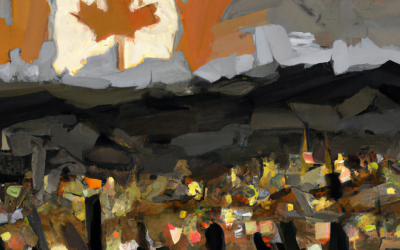Ontario taxpayers will be paying $20 million in compensation for residents and businesses involved in the Caledonia land dispute. The compensation results from a class action lawsuit against Ontario and its Provincial Police (OPP) for inaction in the face of First Nation vigilantes ‘reclaiming’ land they say never to have surrendered.
The Caledonia land dispute touches on many dimensions of justice.
The Rev. Martin Luther King Jr. was right when he said, “justice delayed is justice denied.”
However, King also rejected violence, even against one’s oppressors: “Man must evolve for all human conflict a method which rejects revenge, aggression and retaliation.”
King was not against fighting oppression, but was clear that even civil disobedience was connected to the rule of law and its aim was not anarchy.
Many simplistically say the Caledonia issue is one strictly between Native protesters and peaceful non-Aboriginals. There is more to it than that. Some non-Aboriginal protesters argue that it demonstrates “two-tier justice’ in Canada, where First Nations get away with mayhem and non-Aboriginals are victimized. There is also some truth to that, but it is not the whole story.
The Caledonia dispute stems from First Nation claims over the Haldimand Tract, a 385,000-hectare piece of land granted by the Crown to the Six Nations of the Grand River in 1784 for their loyalty during the American Revolution. In 2006, a private company called Henco Industries intended to build a residential sub-division on a piece of land in Caledonia, Ontario (near Hamilton) within the original land grant. The land is called Douglas Creek Estates. However, the government claimed, with documentary support, that Six Nations surrendered the land in question to them in 1841.
Things got messy when demonstrators from the Six Nations staged a “reclamation” of the land in 2006.
There is validity in demanding the Canadian state fulfill its moral and legal duties to First Nations who have rightful claims to specific land.
Now, the question of choice comes to the fore. What options did the Six Nations have?
Indigenous peoples throughout Canadian history have had to ‘fight’ for their rights. Not through violence mostly, but through persistence and the courts.
It was judicial contention that brought Canada to recognize Aboriginal title and develop a modern land claims policy.
First Nations have access to a system of settlement for past treaty infringements by the Crown. It is called a Specific Lands Claims Policy.
Even if the Six Nations are not part of that process, there is always the courts.
So, there is no question the system has access points for justice. This is not apartheid-era South Africa or 19th-century colonial Canada.
Little known is that the standoff divided Six Nations. Their elected band council initially opposed the reclamation. It was the strident Confederacy Council that went ahead with the action. In fact, other segments, including some Six Nations youth leaders opposed the violence. So, the reclamation was not foregone. Negotiation and more peaceful means could have prevailed.
Even if one favoured the Six Nations position and could see moral value in occupation, there is never excuse for violence, burglary, or intimidation. This is where indigenous people failed.
Governments failed in accepting responsibility. When the standoff blew up, the Ontario and federal governments tossed around the responsibility.
So, the costs of government inaction are borne by ordinary people who are inconvenienced by the reclamation and disruption to their community. It is also borne by taxpayers who pay for a victim settlement when the police don’t do their jobs adequately.
The 2006 Standing Senate Committee on Aboriginal Peoples released a report on specific claims entitled Negotiation or Confrontation: It’s Canada’s Choice. With all due respect to that august body, that is a false choice.
It is not just “Canada’s choice.” It is also about First Nations choosing to work with governments in seeking peaceful solutions.
Confrontation is never inevitable.
Peaceful settlement is good for improving relations and is good economically for everyone involved, as stability allows for development.
Six Nations, like all Natives, deserve justice, but that will come through a political process that arrives at a fair and accurate settlement, not mob violence.
Moreover, if the government decides that the disputed Douglas Creek Estates should go to the Six Nations, it should be because an independent adjudicator decided that was legally and historically correct, not as a way to mollify protesters.
In the end, all parties should review Rev. King’s actions to understand how to achieve justice fairly and peacefully.


